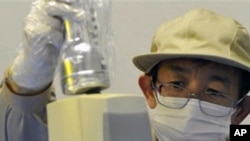A bit of progress is being reported at the Japanese nuclear power plant, crippled by last month's magnitude 9.0 earthquake and resulting large tsunami.
The operator of the severely damaged Fukushima-1 nuclear plant and Japan's government are contending the worst is past, here.
But the president of the Tokyo Electric Power Company, Masataka Shimizu, is again apologizing for causing the month-long crisis that has provoked health and environmental concerns far from Japan.
Speaking at a Tokyo news conference Wednesday, Shimizu said the company is preparing to compensate those living near here, mainly farmers and fishermen whose livelihoods have suffered because of Japan's worst nuclear plant accident.
He also vowed to heed Prime Minister Naoto Kan's call for the company to quickly take measures to alleviate the danger. In that regard, Shimizu says the utility is thinking about moving exposed radioactive fuel rods to a safer place, away from the damage.
In the meantime, pumper trucks, normally used to pour concrete, are spraying tons of water on the exposed used fuel rods. The fuel needs to be kept immersed in water to avoid heating to dangerous temperatures that could cause them to stream high levels of radiation
into the atmosphere.
Work also continues to pump 900 tons of toxic water out of an underground trench next to a turbine building. The presence of the highly radioactive water has hampered other repair work.
The damage control effort has been repeatedly interrupted in recent days by large aftershocks. Those tremors compel workers to stop what they are doing and take cover until it is clear the quakes have not inflicted further damage and that a fresh tsunami has not been generated.
It was the magnitude 9.0 quake and resulting tsunami - which is estimated to have reached as high as 15 meters here - that crippled four of the plant's six reactors. It is still not certain just how badly the reactors have been damaged. Two other reactors were out of
service on March 11 and were not damaged. Japan's government says some of spent fuel rods for at least one of the reactors have partially melted.
Officials Wednesday defended their delay in officially deeming the disaster on par with the 1986 explosion at the Chernobyl nuclear power plant in the former Soviet Union. The Level Seven indication means this is a major accident with widespread implications for human health and the environment.
The government says it did not have sufficient data earlier to make the assessment to shift Fukushima from a Level Five.
However, Japan's nuclear safety agency is stressing that the total radiation spewed from Fukushima is still less than one-tenth of what leaked from Chernobyl, the world's worst nuclear power plant accident.
Workers here are trying to keep it that way, while avoiding exposure above the Japanese government's recently expanded limit of radiation for those at nuclear facilities.
The nuclear crisis has compounded Japan's misery. The triple tragedy, involving the earthquake, tsunami and radiation, is estimated to eventually cost Japan up to $300 billion, making it the world's worst natural disaster.
Progress Reported at Crippled Japanese Nuclear Plant














